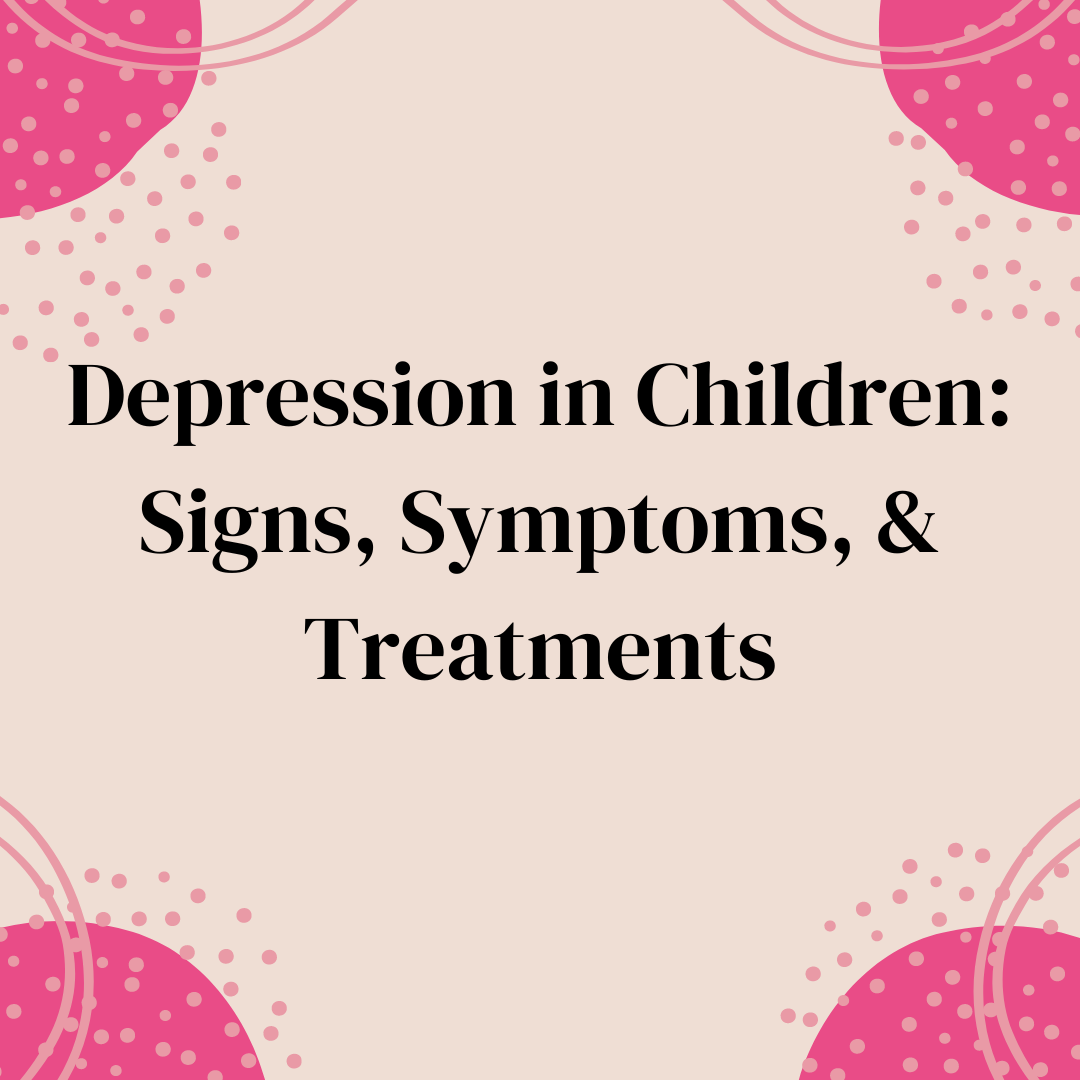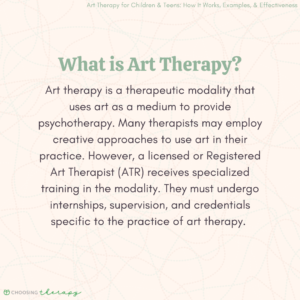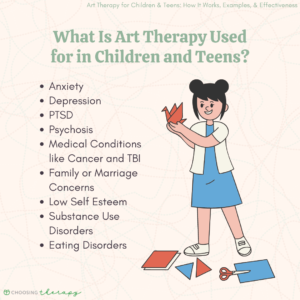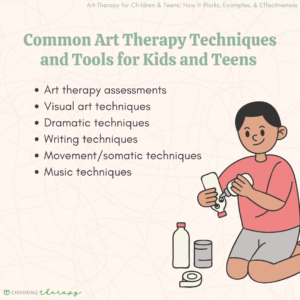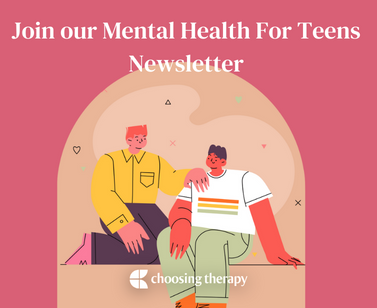Art therapy is a form of expressive therapy that uses art to diagnose and treat behavioral health disorders. Art therapy is effective for people of all ages. Still, it can be especially beneficial for treating children and teens due to the ability of art to convey thoughts and feelings without complex verbal exchanges and for teens without the stigmatizing associations of traditional therapy.
Are you obsessively asking yourself “Am I a good parent?”
Most parents occasionally ask themselves the question. However, if you are constantly worried about being a good parent and cannot control your fears, you might have OCD. Learn More
What Is Art Therapy?
Art therapy is a therapeutic modality that uses art as a medium to provide psychotherapy. Many therapists may employ creative approaches to use art in their practice. However, a licensed or Registered Art Therapist (ATR) receives specialized training in the modality. They must undergo internships, supervision, and credentials specific to the practice of art therapy.
Art therapy can take on two distinct but related forms. Art used “in” traditional talk therapy is a complementary modality to enhance other therapeutic techniques, while art used “as” therapy means therapeutic processing is done through creative artistic expression.
Art used in therapeutic settings may include creating art as well as the practice of sharing, viewing, and appreciating art together. As with any therapeutic approach, the purpose of the therapy is to improve overall mental health.
Art therapy may help in areas, such as:
- Communication
- Trauma processing
- Physical capabilities
- Emotion management
- Cognitive functioning
- Social ability
Therapists can accomplish the goals of psychotherapy through a broad range of artistic mediums, including:
- Visual art
- Creative movement
- Music
- Drama
- Journaling
- Expressive writing
Art therapy shares similar elements to traditional therapy, such as:
- Assessment for disorders
- Rapport building
- Treatment planning
- Documentation of progress
Help Your Children Develop & Be Happy
Online Therapy & Coaching (ages 1 -17) Bend Health is a virtual mental healthcare provider caring for kids, teens, and their families. Many insurance plans are accepted. Learn More
Charlie Health – Does your teen need additional mental health support? Charlie Health creates personalized treatment plans for young people (ages 11+) that include individual therapy, family therapy & curated peer groups. 92% of parents & caregivers would recommend Charlie Health to a friend or family member. Insurance accepted. Learn More
Thriveworks – In-person or Online Therapy – Therapy can change your child’s life. Connect with a licensed therapist online or in-person, and cover most of the cost with your insurance. Click here to Find A Therapist or call (877) 314-3813
How Is Art Therapy Adapted for Children & Teens?
Art therapy helps treat children and teens by allowing the therapist to share a non-threatening experience with the client through artistic creation, appreciation, and expression. Art therapy for children and adolescents emphasizes that art is essential in social and emotional learning. Therapists can assist children in exploring feelings they cannot express through words.1
Techniques employed by the art therapist may be more or less directive depending on the therapeutic style and age group. The experiential element of discussing symbols and meanings revealed in art may change based on the clients’ developmental stages. For example, adolescents can work with more sophisticated techniques using music, dance, dramatic arts, and journaling (i.e., examining lyrics, movements, or theatrical methods).2
Art therapists may choose visual mediums, such as:
- Crayons,
- Watercolors
- Clay
- Acrylic Paints
- Pencils
- Paper Craft Materials
- Sand Trays
Common Art Therapy Techniques & Tools for Kids & Teens
Art therapists often work with a specific age group or have preferred methods and modalities that represent their unique scope of practice. Some of the techniques used depend upon the setting of art therapy in hospitals, private practices, assertive community mental health, and school counseling.
Here are six standard art therapy techniques for kids and teens:
1. Art Therapy Assessments
Art therapists may employ standardized assessments that any therapist would use, such as depression or anxiety screenings. They may also use evaluations specific to Art Therapy, such as Draw a Person, House-Tree-Person, Diagnostic Drawing Series, or the Levick Emotional and Cognitive Art Therapy Assessment
2. Visual Art Techniques
These techniques can offer a glimpse into emotional schemas and help guide corrective emotional experiences. The client and the therapist discuss the choices of materials, colors selected, symbols used, the elements in the art, and the themes they want to explore.
Visual art techniques might include:
- Spontaneous Drawing
- Collages
- Sculptures
- Mandalas
- Drawing a Family
3. Dramatic Techniques
Art therapists may guide the client through a psychodrama technique such as the “empty chair” or family sculpting. These techniques can help the therapist form a clinical picture of the disorder, help the client become more aware of emotional patterns, and provide an opportunity to develop emotional regulation.
4. Writing Techniques
Letter writing, journaling, and poetry can spur post-traumatic growth and are standard therapeutic techniques. These techniques provide a safe container to express complicated feelings in constructive or corrective emotional experiences.
Therapists may give specific writing assignments such as:
- Describing an ideal day
- Practice expressing gratitude
- Exploring details of a dream or memory
5. Movement/Somatic Techniques
Dance and pantomime are standard movement techniques that allow for emotional expression, exploration, and the development of new behaviors.
6. Music Techniques
The appreciation or identification of music that elicits different mood states are among music techniques that can teach mindfulness skills, mood management, and nhanced ability to express emotions. These techniques can be practiced with drum circles, playing instruments together, and group listening as a way to use those skills in social settings.
Are you obsessively asking yourself “Am I a good parent?”
Most parents occasionally ask themselves the question. However, if you are constantly worried about being a good parent and cannot control your fears, you might have OCD. Learn More
What Is Art Therapy Used for In Children & Teens?
Art therapy techniques are used in various settings and are effective for many mood and behavioral disorders. The recent popularity of coloring books, travelers’ notebooks, and Zentangle guides demonstrates that the creative process is calming or therapeutic for many people on an intuitive level. However, seeing an art therapist will give you the added involvement of experienced specialists who can plan treatment goals and interventions to reach meaningful outcomes.
Chief complaints that make a child or adolescent a candidate for art therapy includes such disorders or identified needs as:
- Childhood anxiety
- Childhood depression
- Post-traumatic stress disorder (PTSD)
- Psychosis
- Medical conditions like cancer and TBI
- Family or marriage concerns
- Low self-esteem
- Teen substance use
- Eating disorders
Art Therapy for Conduct Disorders
Art therapy is a growing treatment for children with behavioral concerns and juvenile delinquency in some countries.3 Art therapy provides youth with conduct disorders with healthy ways to express sadness and regret, recover from trauma, or find alternatives to avoid further criminal activity or violent acts of revenge.
Art Therapy for Depression
Depression is one of the most common forms of emotional dysregulation, ranging from mild to severely debilitating illnesses. Art can increase the production of dopamine to help raise mood. The value of creativity also involves anxiety reduction and self-discovery.
Therapists can integrate cognitive behavioral therapy for depression with art therapy into a new modality called cognitive behavioral art therapy (CBAT). CBAT can help people suffering from depression develop flexible approaches to situations, understand their cognitions, and improve their ability to generate solutions.
Art therapy techniques to help reduce depressive symptoms include:
- Providing an opportunity to express and observe their negative thoughts
- Exploring the hidden symbols and meaning in their artistic expressions
- Learning to accept their feelings by seeing them from new perspectives
Art Therapy for Eating Disorders
Eating disorders are severe illnesses and highly complex psychological conditions that can be challenging to treat uniformly. They may also result in relapses of depressive symptoms and present with severe, sometimes life-threatening medical complications.
Sufferers of eating disorders develop patterns of secrecy and shame around their bodies. Art therapists often have their clients create artistic masks to demonstrate the differentiation of self seen by the world versus the self within. This exercise can be particularly effective with eating disorders, allowing clients to explore their self-awareness through the lens of their “outer” and “inner” selves.
Therapists can also use drama, dance, and expressive musical experiences (with particular care to avoid overuse for those with exercise addiction or for sufferers of anorexia). The intent is to help clients create healthy connections to their bodily sensations. Eating disorders can leave sufferers disconnected from themselves, leading to poor control of food intake.
Charlie Health - Therapy Once Per Week Isn’t Always Enough Charlie Health’s virtual mental health program includes curated peer groups, individual therapy, and family therapy for teens and young adults with serious mental health issues. Insurance accepted. Learn More
Art Therapy Timeline for Children & Teens
Interventions depend upon the severity of the chief concern. Sessions are typically 50 minutes and are often weekly to build on progress. Planning for a 3-6 month timeline is a reasonable expectation. Completion depends on the treatment plan, an individualized and collaborative process with goals that address the most distressing symptoms or concerns.
Art therapists might extend treatment plans until they feel the identified coping skills or improvements are acquired, indicating readiness for transition.
Examples of criteria needed for graduation from an art therapy program might be:
- Fewer feelings of worthlessness
- Overcoming hopelessness for depression sufferers
- An increased impetus to do activities
- Finding pleasure again in previously enjoyable activities
Is Art Therapy Effective for Treating Children & Teens?
Art therapy can receive criticism for lack of clarity around its mechanisms of change in the brain. But there have been countless research results and meta-analyses to substantiate evidence-based use in improving cognitive ability. A 2021 study noted that evidence demonstrates that creative art therapies are effective, with more data to support this coming every day.4
An extensive study on the effectiveness of art, dance, drama, and music therapy concluded that the mental health benefits of art therapy come from its Adaptive Response Theory. The theory framework allows users to shift from maladaptive (like daydreaming) to adaptive responses by developing a new interpersonal and intrapersonal connection to the world they live.4
How to Find an Art Therapist for Your Child/Teen
If you are looking to find a therapist for your child who specializes in art therapy, begin by asking their school guidance office or pediatrician for recommendations. Alternatively, your insurance company may have a list of preferred providers. Additionally, an online therapist directory may allow you to review the options and find a therapist at home. Most therapists offer a consultation to help you choose a therapist who best fits your child’s needs.
At-Home Art Therapy Exercises for Kids & Teens
Families can borrow from successful art therapy techniques to help them have fun, connect with their children, recognize and process their emotions, and understand each other better.
Some art therapy exercises you can use at home with children include:
- Draw or paint your emotions: Bring out an array of painting and coloring supplies to draw or paint your emotions. Facilitate communication by asking about the symbols used, choice of color, or use of space. See if family members can guess what emotion the drawing represents. Expand this activity by drawing or painting the feelings about a piece of music.
- Journaling: Families can have fun creating a joint or individual journal using an inexpensive notebook or making a journal as an art project. You can give journals particular themes such as gratitude, nature, or family travel journal. You can search journal prompts (such as those for anxiety) on the internet and even find them on youtube.
- Zentangle: This word is a technique of mindfully drawing within a small square. This technique’s endless variations can help children and teens learn to slow down, concentrate, breathe mindfully and be in the moment.
Final Thoughts
Art therapy for children can be an effective and productive way to help your children cope with various mental and physical ailments. Consider reaching out to your child’s pediatrician, school counselor, or other local resources to locate a nearby art therapy provider.
Additional Resources
To help our readers take the next step in their mental health journey, Choosing Therapy has partnered with leaders in mental health and wellness. Choosing Therapy is compensated for marketing by the companies included below.
Online Therapy & Coaching (ages 1 -17)
Bend Health is a virtual mental healthcare provider caring for kids, teens, and their families. Many insurance plans are accepted. Learn More
Virtual Therapy For Teens
Charlie Health creates personalized treatment plans for young people (ages 11+) that include individual therapy, family therapy & curated peer groups. 92% of parents & caregivers would recommend Charlie Health to a friend or family member. Insurance accepted. Learn More
In-person Or Online Therapy For Children & Teens
Thriveworks – Therapy can change your child’s life. Connect with a licensed therapist online or in-person, and cover most of the cost with your insurance. Click here to Find A Therapist or call (877) 314-3813
Online Therapy
TeenCounseling (ages 13 -19) – Help your child thrive with professional counseling. Get matched with a licensed therapist who specializes in teens. Discuss your child’s issues and situation. When you approve, the therapist is connected with your child. The therapist interacts with your child over text, phone, and video. Starting for as little as $65 per week. Get Started
OCD and Children
NOCD – What are the signs of OCD in children? OCD involves unwanted intrusive thoughts, images, or urges (obsessions) that create anxiety, which the child attempts to relieve by performing rituals (compulsions). These rituals can be overt and noticeable (e.g. handwashing, counting, avoiding objects, rearranging materials, etc.) or can be less noticeable or mental (e.g. silently analyzing, reiterating phrases, counting, etc.). To find out if your child has OCD and treatment options, schedule a free 15 minute call with NOCD.
How to Find & Choose the Right Therapist for Your Child Discovering and selecting the right therapist for your child often comes down to two things: research and persistence. Be willing to put in the time and effort to call around to different therapists or therapy organizations in your area. Read through therapist profiles to see if their style, approach, and expertise resonate with you and your child.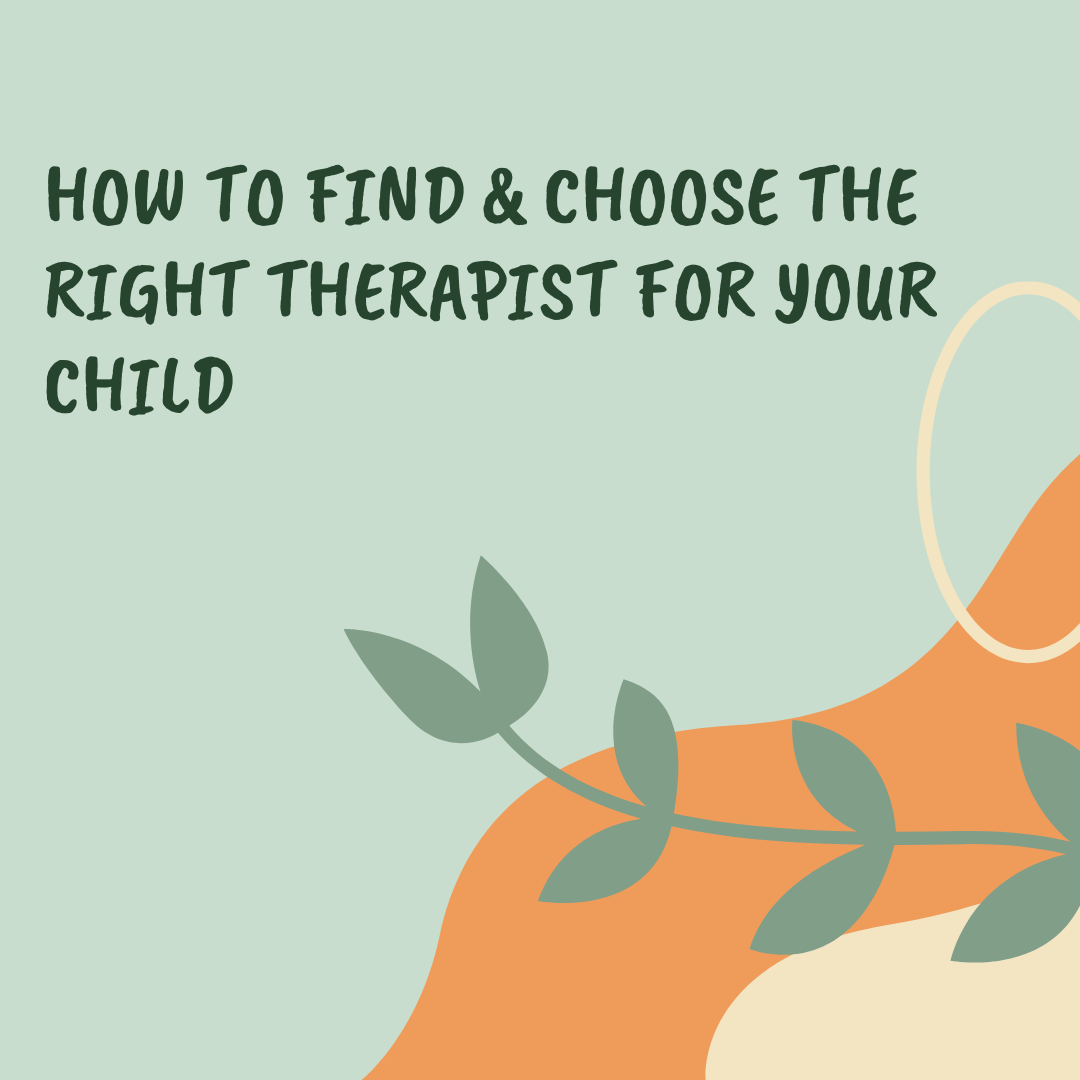
Depression in Children: Signs, Symptoms, & Treatments If you or someone you know is concerned about symptoms related to depression, seeking professional help from a mental health provider is highly recommended. Licensed professional counselors, social workers, psychologists, or psychiatric medication prescribers are able to determine whether a person is experiencing depression and the best methods of treatment.